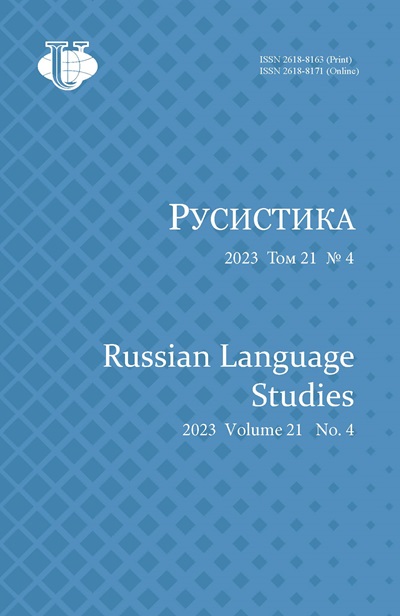COMPLIMENT AND PRAISE AS MANIFESTATIONS OF EMPATHY IN SPANISH
- Authors: Shalyukhina A.V1
-
Affiliations:
- Spanish department Moscow State Institute of International Relations (University) of Ministry of Foreign Affairs of Russia
- Issue: Vol 15, No 1 (2017)
- Pages: 91-102
- Section: Articles
- URL: https://journals.rudn.ru/russian-language-studies/article/view/16032
- DOI: https://doi.org/10.22363/2313-2264-2017-15-1-91-102
Cite item
Full Text
Abstract
This article shows the importance of empathy in Spanish communication, describes compliment and praise as culturally conditioned verbal ways of expressing empathy in Spanish and Russian and their role in dialogic communication. The author Observes genre differences between these two types of replicas within rejectlog approach. The examples are taken from the novel by modern Spanish writer Torcuato Luca de Tena “Los renglones torcidos de Dios”. The author makes conclusion about the necessity of studying communicative functions of compliment and praise in teaching a foreign language to avoid failures in communication.
Keywords
About the authors
Anna V Shalyukhina
Spanish department Moscow State Institute of International Relations (University) of Ministry of Foreign Affairs of Russia
Author for correspondence.
Email: shaliukhina.a@yandex.ru
teacher of Spanish Department of MGIMO University, PhD applicant in Philological Sciences
Prospekt Vernadskogo, 76, Moscow, Russia, 119454References
- Shahovskij V.I. Kategorizaciyaehmocij v leksikosemanticheskojsistemeyazyka. [Categorization of emotions in the lexicosemantic system of language].Moscow: Nauka, 2008. 208 p. (in Russ)
- Vasilyuk F.E. Semiotikaitekhnikaehmpatii [Semiotics and technique of empathy]. Voprosypsihologii. [Questions of psychology], 2007. № 1. P. 3—14. (in Russ).
- Kuznecova A.A. Lingvisticheskijaspektehmpatii [The linguistic aspect of empathy]. Vestnik Chelyabinskogogosudarstvennogouniversiteta [Chelyubinsk State University Vestnik]. 2010. № 43. P. 80—82. (in Russ)
- Chao Chen. Empathy in Language Learning and Its Inspiration to the Development of Intercultural Communicative Competence. [Theory and Practice in Language Studies]. 2013. № 12. P. 88—101.
- Formanovskaya N.I. Upotreblenierusskogorechevogoehtiketa. [The use of the Russian speech etiquette]. Moscow: Russkiyyazik, 1984. 198 p. (in Russ)
- Luca de Tena. T. Los renglones torcidos de Dios. Barcelona: Planeta Bolsillo, 1992. 345 р.
- Brown P., Levinson S. Politeness — Some universals in language usage. Cambridge: Cambridge University Press, 1987. 345 p.
- Zvereva E.V. Formyobrashcheniya v komplimentah, ispol’zuemyh v ispanskomyazyke [Forms of adress in compliments employed in the Spanish Language]. Vestnik Finansovogo Universiteta [Financional University Vestnik], 2013. № 2. P. 76—83. (in Russ)
- Leont’ev V.V. Pohvala, lest’, kompliment v struktureanglijskojyazykovojlichnosti: avtoref. ... kand. filol. nauk [Praise, flattery, a compliment in the structure of English language personality avtoref. ... kand. filol. sci] Volgograd, 1999. 19 p. (in Russ)
- Gorobec, O.B.Pohvalaikompliment: mezhzhanrovyegranicy. Uchen. zap. Komsomol’skogonaAmuregos. tekhn. unta, 2010. № 2II(2). URL: http://www.uzknastu.ru/files/pdf/II2(2)2010/7580.pdf (data obrashcheniya: 12.08.2014). (in Russ)
- Adamzik K.SprachlichesHandeln und sozialerKontakt. Zur Integration der Kategorie „Beziehungsaspekt” in einesprechakttheoretische Beschreibung des Deutschen. Tübimgen, 1984. 365 p.
- D’jachkova I.G.Pohvalaiporicaniekakrechevyezhanry (pragmaticheskijanaliz) [Praise and blame as speech genres (pragmatic analysis)]. Vestnik Omskogo Universiteta. [Omsk University Vestnik], 1998. № 3. P. 55—58. (in Russ)
- Leisi E. Paar und Sprache. LinguistischeAspekte der Zweierbeziehung. Heidelberg: Quelle und Meyer, 1978. 167 p.
- Zemskaya E.A. Kategoriyavezhlivosti v konteksterechevyhdejstvij [Category of politiness in speech actions].Logicheskijanalizyazyka. Yazykrechevyhdejstvij / Pod red. N.D. Arutyunovoj. Moscow: Nauka, 1994. P. 131—137. (in Russ)
- Astakhova E.Piropocomofenomenolingüísticо y sociocultural en el espacio español. [Cuadernos iberoamericanos]. 2014. № 1(3). P. 99—108.















